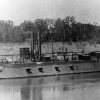calsfoundation@cals.org
CSS General Earl Van Dorn
aka: CSS Van Dorn
aka: CSS Earl Van Dorn
aka: CSS General Van Dorn
aka: Junius Beebe
The CSS General Earl Van Dorn was a Confederate ram that saw combat on the Mississippi River before being set afire and blown up on the Yazoo River in 1862.
The steamboat that would become the CSS General Earl Van Dorn was built as the Junius Beebe in Algiers, Louisiana, in 1853. The sidewheel towboat was 182 feet long, 28.3 feet wide, and 10.7 feet deep and was owned by the Good Intent Towboat Company.
The Confederate army acquired the Junius Beebe in 1862 and fitted the vessel out as a ram with a new name honoring the general who commanded Confederate troops at the Battle of Pea Ridge. The Van Dorn was attached to the Mississippi River Defense Fleet. The vessel left New Orleans, Louisiana, on March 25, 1862, and was sent to Memphis, Tennessee, where by April 10 the ironwork was completed to make it a warship, armed with a 32-pounder cannon. Captain Isaac D. Fulkerson was in command.
A month later, on May 10, the Van Dorn and the rest of the Confederate fleet steamed up the Mississippi toward Fort Pillow at Plum Point Bend, which was under fire from Federal Mortar Boat 16 under the watchful eye of the USS Cincinnati. As other Confederate ships engaged with vessels of the U.S. Mississippi Flotilla, the Van Dorn hugged the Arkansas shore and fired on the mortar boat until the USS Mound City steamed within range. The Van Dorn then rammed the Union vessel, almost shearing off its bow. As the captain of the Mound City ran the sinking vessel aground on the Arkansas shore, the Van Dorn steamed across the river and ran ashore on the Tennessee side of the Mississippi, taking fire from five Federal gunboats before the Confederate vessel could free itself and head back down the river to join the rest of the fleet. As the USS Benton and USS Carondelet opened fire on the Confederate fleet, its commander, Captain James E. Montgomery, ordered it to fall back to the protection of Fort Pillow’s guns, ending the engagement. One sailor was killed, and Captain Fulkerson was wounded aboard the Van Dorn during the Engagement at Plum Point Bend.
The River Defense Fleet and the Van Dorn were back on the waters at Plum Point Bend in early June, holding off the Federal fleet as Confederate forces abandoned Fort Pillow, after which the fleet fell back to Memphis to refuel.
On June 6, 1862, Flag Officer Charles H. Davis led the U.S. Mississippi Flotilla to Memphis, where Confederate commander Montgomery, his boats still low on fuel, swung out to engage them. It was a disaster for the Rebel fleet as every one of its vessels was either destroyed or captured—only the Van Dorn escaped to the south because of its superior speed.
The Union rams USS Lancaster and USS Monarch pursued the Van Dorn, chasing the Confederate ram down the Mississippi, then up the Yazoo River, where on June 26 the Van Dorn and two other ships were set afire at Yazoo City to prevent their capture. The CSS General Earl Van Dorn, burning and adrift, exploded.
For additional information:
“General Earl Van Dorn.” Dictionary of American Fighting Ships. Online at www.hazegray.org/danfs/csn/g.txt (accessed May 25, 2022).
McCaul, Edward B., Jr. To Retain Command of the Mississippi: The Civil War Naval Campaign for Memphis. Knoxville: University of Tennessee Press, 2014.
Tomblin, Barbara Brooks. The Civil War on the Mississippi: Union Sailors, Gunboat Captains, and the Campaign to Control the River. Lexington: University Press of Kentucky, 2016.
Way, Frederick, Jr., comp. Way’s Packet Directory. Athens: University of Ohio Press, 1983.
Mark Christ
Central Arkansas Library System
 Civil War through Reconstruction, 1861 through 1874
Civil War through Reconstruction, 1861 through 1874 Military
Military Steamboats (Civil War)
Steamboats (Civil War) Earl Van Dorn
Earl Van Dorn 




Comments
No comments on this entry yet.